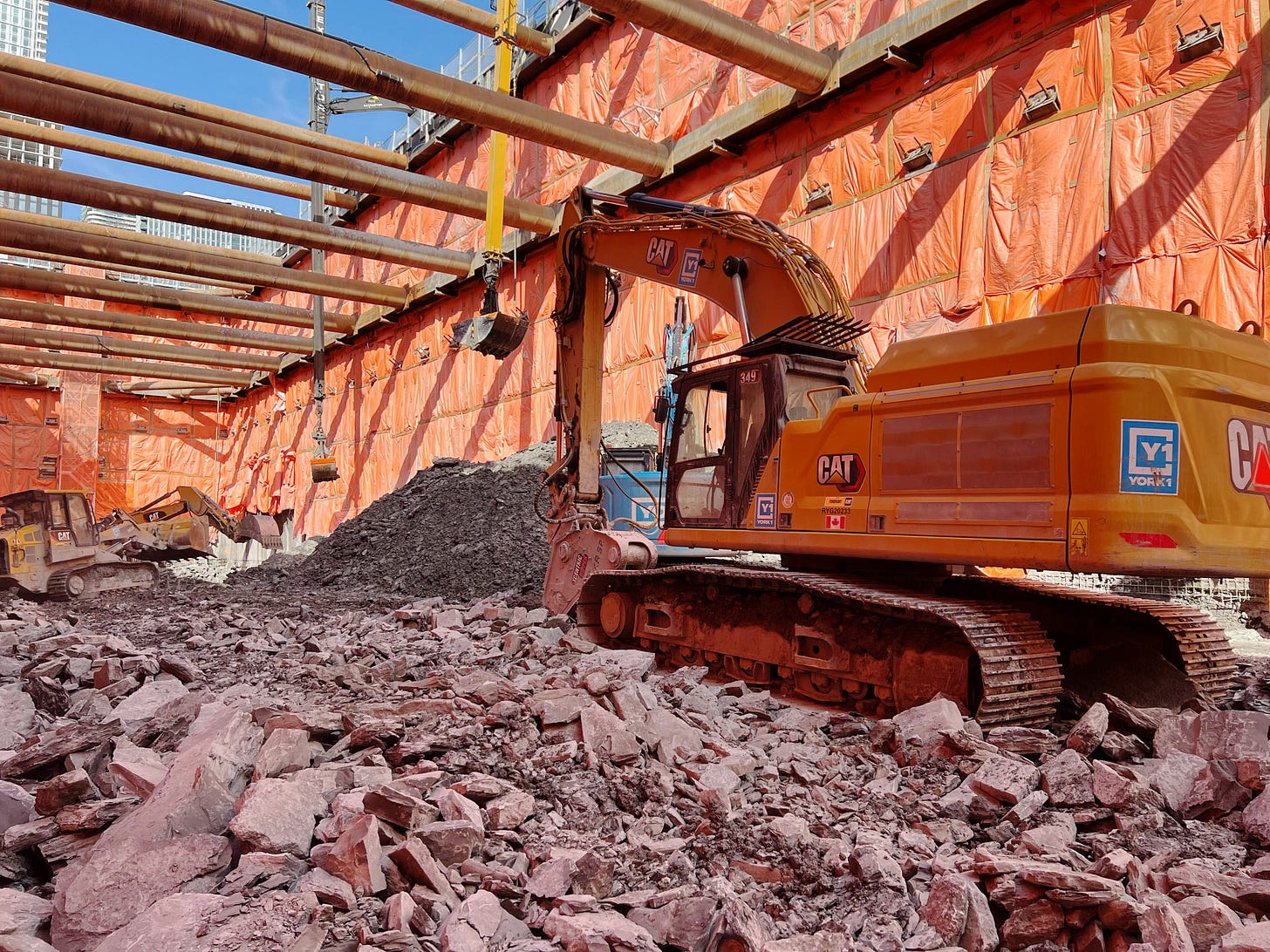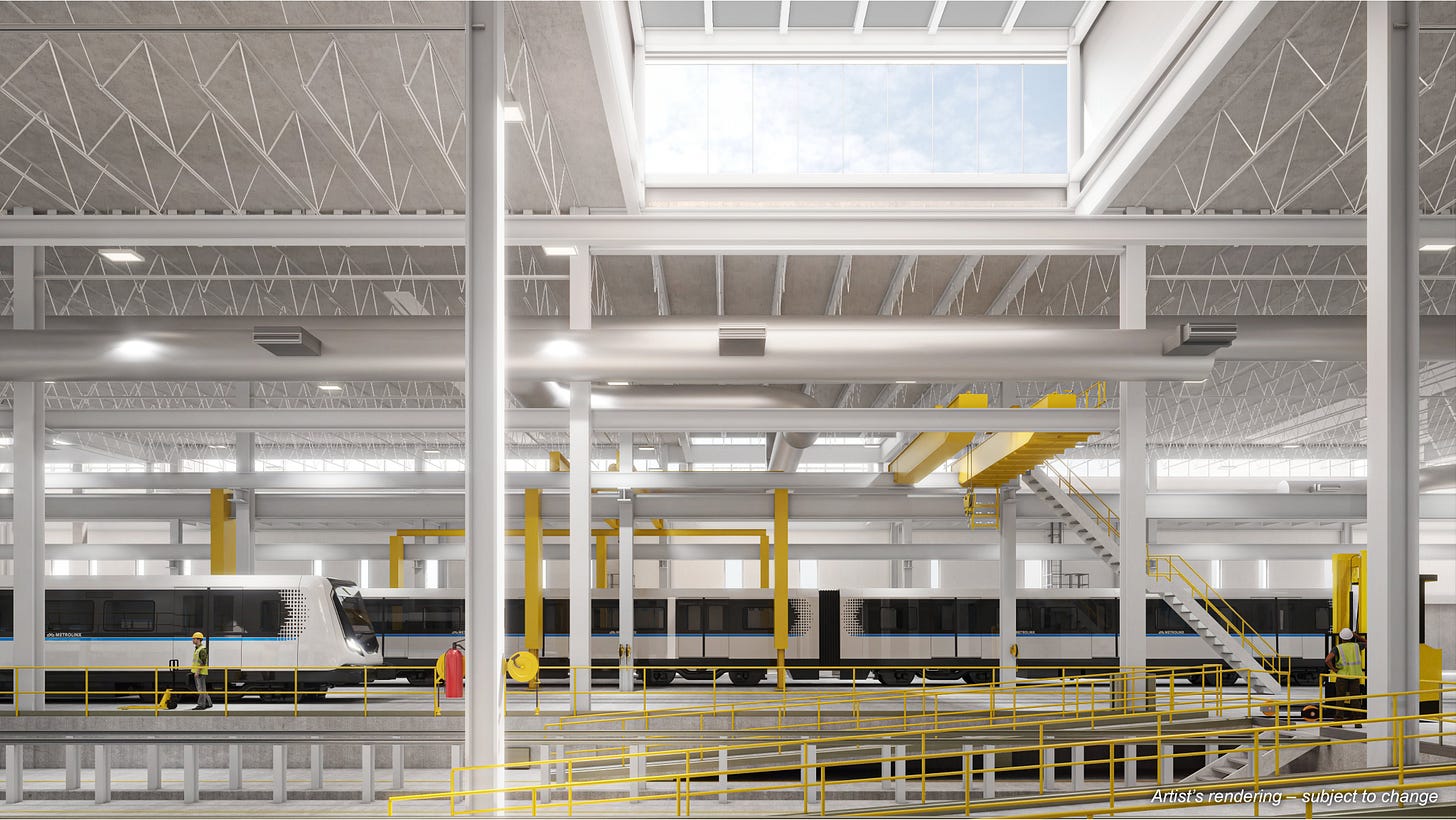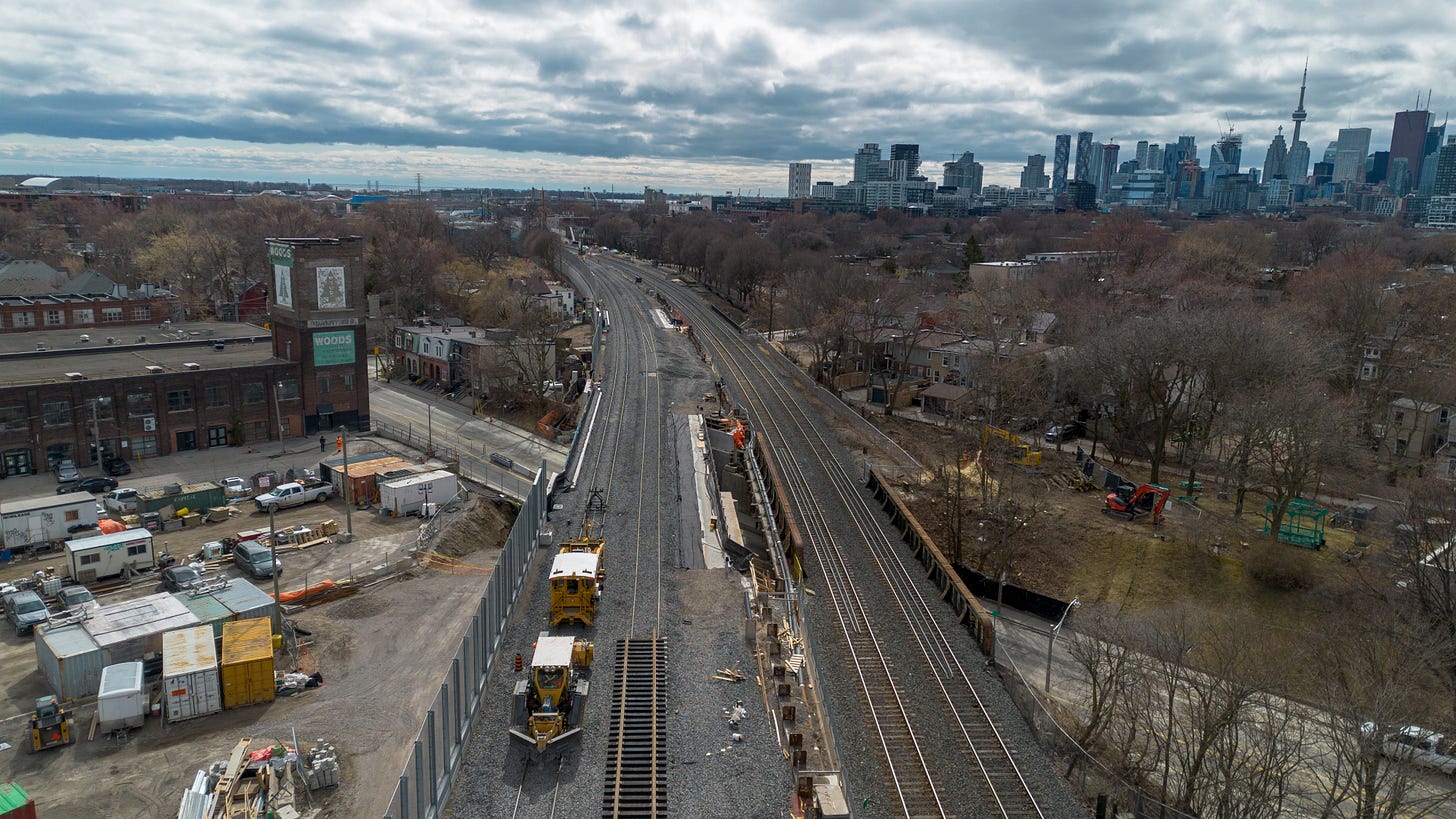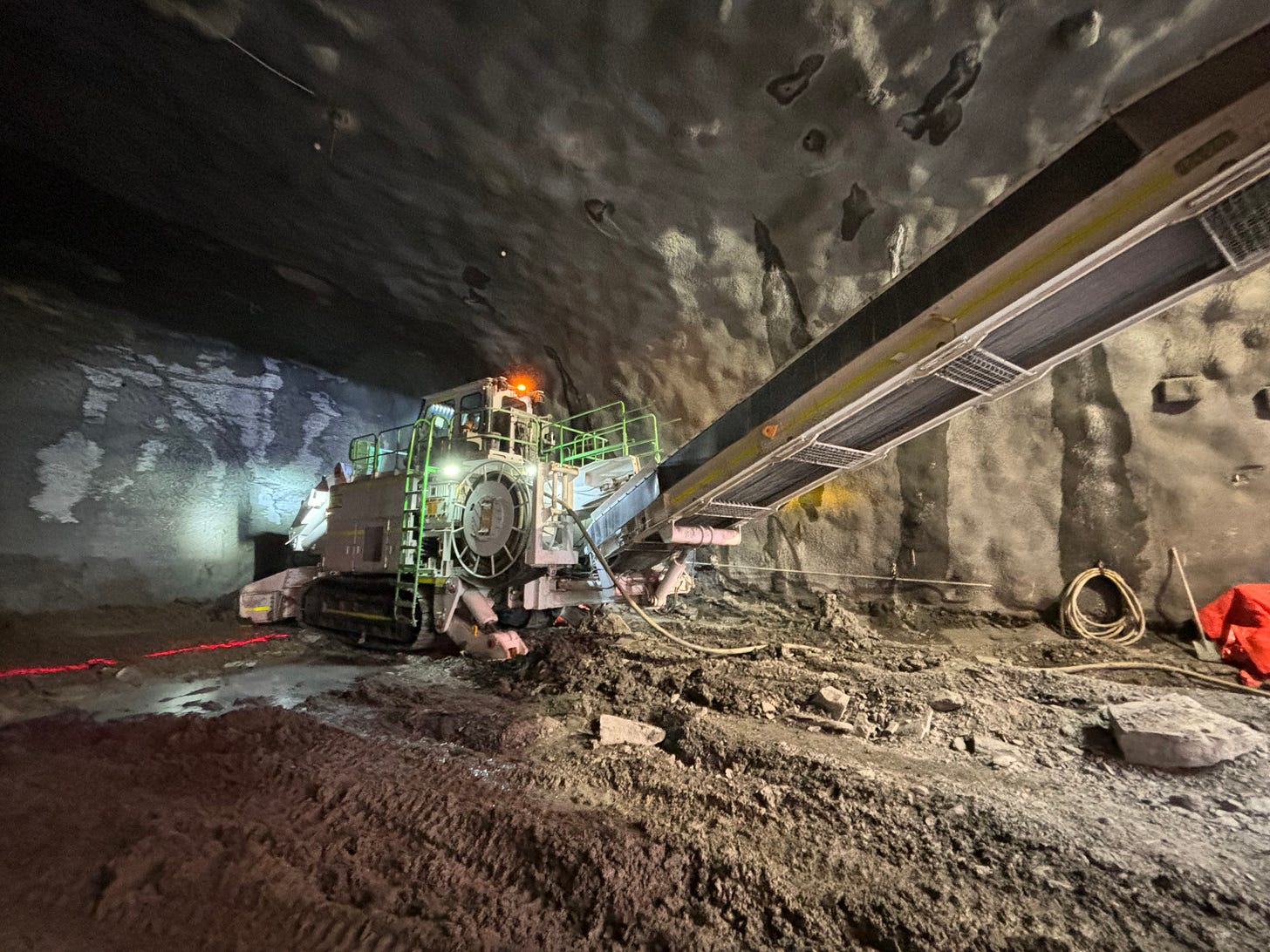Toronto: Canada's Most Important Transit Project Leaps Forward.
People Continue to Underrate the Ontario Line.
Toronto is building a lot of transit projects, which is generally under-appreciated outside of the city. Of course, what’s more shocking is that this big transit expansion is under-appreciated within the city, and to the extent there is talk of transit expansion beyond a project that might personally impact someone in their day to day, it’s probably about how brutally delayed the Eglinton Crosstown is.
Now, people are right to be annoyed about Eglinton (though I am surprised that people don’t talk more about what they might be missing out on — faster service to places that are annoying to get to on transit now). But, what’s even more surprising is the extent to which people barely talk about the Ontario line, which is a much grander project than Eglinton — arguably even with the latter’s megaproject-in-its-own-right western extension towards Mississauga and Pearson airport.
If is true that Eglinton will be our first large-scale rapid transit project since the 1960s in Toronto (make sure you’re subscribed for a blog post on this — since the line will be opening soon), but the Ontario line will be our first subway (no, Sheppard does not count as a large-scale project — it’s basically a branch without through operation!), and as someone who’s made a career on distinguishing “light rail” from subways, that’s a big deal.
I wanted to say the Ontario line is the biggest transit project in North America in terms of impact, and in some senses that’s probably true — the only project it would be competing with for that title is the second pair of Hudson tunnels in New York. But, that’s a very different project in a much larger city — and it’s really about capacity and resilience, and evolution not revolution. The new Hudson tunnels will allow more trains to run (eventually), and might even enable transformative service if followed up with the right redesign of Penn station. However, the Ontario line will be transformative from the first day it opens — in short order, it should be carrying close to half a million people every day (imagine adding almost the entire ridership of subway line 2 in a single project) — more than the urban section of Highway 401. And it’s going to attract those riders because it’s going to make all kinds of journeys possible that are not today.
So I wanted to write a post highlighting to people some of the many ways that this project is going to change the dynamics around transit in Toronto and the city itself. It’s going to change our city’s geography, its physical structure, the ways people think about getting around, and supercharge what is already probably the continent’s second largest downtown.
It Is Happening Fast.
There is no getting around the price: the Ontario line is one of the most expensive subways ever built, but I’m going to argue here that the value delivered is actually better than many of our recent projects. For example, while the Ontario line is a little over twice the price of the Eglinton Crosstown, it will have several times more riders every day; I also expect it to drive far more development. The project is also somewhat unique in that it combines several major endeavours into one project — which I will talk about in the sections on activity centres and the project’s immense scale.
But, probably the most notable thing about the project is the relentless pace it seems to be moving at. The planning process was fast, and construction, which is moving very quickly, has already made notable visual changes to the city.
Already, many of the downtown stations have seen a large portion of their excavation completed, and given these are big stations (much bigger than those on Eglinton) that’s no small feat.
The extent of construction is also substantial. It’s been a long time since a single project stretched across the core of Toronto and so far into its outer boroughs. All to say that, while the project is costing a lot, I think people might be more accepting of a high price if the project doesn’t feel like it’s plodding along for a decade.
It Will Set A New Standard as the Best Subway in North America.
And the Ontario Line won’t just be any subway. It will jump to the top of the bunch in North America with modern features that are few and far between here, and all built into the system from day one.
A big one for me given a recent report talking about the retrofitting of screen doors onto the Toronto subway is... screen doors, which will be present at every platform. These will make the system safer, more reliable, and higher capacity.
And screen doors are natural because the Ontario line will have no drivers, being centrally-controlled by a small set of remote overseers at the operations and maintenance centre. Automated rail lines are nothing new and both Vancouver and Montreal already have them, however Toronto is Canada’s biggest city and “automated vehicles” are a hot topic these days, so I think the impact on people’s perception of transit will be different. Plus, being automated means incredible views out of the front window, including of the downtown skyline and the Don Valley, which will surely be all over social media.
With automation pretty naturally comes frequency (since there are no drivers needed to ramp the service up and down), which the Ontario Line is designed around. The line is designed to enable frequencies at peak times of 90 seconds, which means a train will be arriving at each platform every minute and a half — or forty times every hour during peak periods. With this level of frequency people will not care about missing a train (sadly becoming an issue on the regular subway with its mismanagement). I think a real underrated element on the Ontario line will be reminding people how good subways should be, and putting pressure on the TTC to do better (the Ontario line will not be run by the TTC for at least its first 30 years of operation), but also offering an opportunity for learning. I bet that part of the TTC seemingly getting more into the idea of screen doors is the Ontario line implementing them and the potential impact this has on the way the legacy subway looks.
Now, what is less well understood is that the Ontario line should also be a lot faster than the regular subway. Stations are spaced further apart in the core of the city, and the trains will receive more power from overhead lines, plus everything on the line is designed for speed. Combine this with the very high frequencies (which reduce time spent waiting around) and I think the Ontario line will quickly build a reputation for being quick.
And then there’s one of the biggest features of all. Along with the Eglinton Crosstown, the Ontario line helps turn a page in transportation planning in Toronto by linking the urban subway and the traditionally suburban GO train networks together. The Crosstown will have three major interchanges with GO lines heading to the north of the city, and will form a three-quarter loop around central Toronto and midtown with the Ontario line, which will intercept GO rail services headed to the east and west of the region outside of downtown.
Toronto: A Huge Setback for the Greatest Transit Project in Canadian History, and How to Save It
Welcome to my new blog, where I’ll be covering transit around the world and at home in Canada (expect an article soon on the new LAX rail link), much as I once did on RMTransit, make sure to subscribe for free to support the blog and join me in my mission to spread good ideas about public transport around the world.
Connecting with GO is fantastic, especially because the system is already transitioning into an all-day network, with trains heading into and out of the city from morning to night. But what makes the Ontario Line’s connections particularly great is that both East Harbour (to the east — naturally) and Exhibition (to the west) will be big stations that can actually handle the huge volumes of people that will naturally be going between some of the busiest subway and regional train lines in the country in the orbit of downtown Toronto. If you look at Bloor-Dundas West station or Kennedy, these are also major hubs, but they will likely need big rebuilds down the road to cope with the traffic — they lack really wide platforms, escalators, and circulation space, they feel in between the bus shelters and curbs of old GO stations and the rapid transit stations we need; the Ontario line stations at East Harbour and Exhibition do not.
Creating New Activity Centres.
And those major hubs are two fold. They will be great transit exchanges, but because of that, they will also be excellent neighbourhood hubs, both for already established Liberty Village, and for the as-of-yet nonexistent East Harbour and the Port Lands. Businesses should be able to thrive in both of these locations because of the great connectivity and huge numbers of people passing through, but they will also be good places to meet people — accessible with a single change from almost anywhere in the region, and with large comfortable facilities.
The stations will also ground and form centres for what are, and will be some of the continent’s densest neighbourhoods, which will be a confluence of transportation modes — with streetcars and buses also present, and bike and pedestrian infrastructure constantly improving, but also sites of major civic amenities, with the Exhibition grounds and their numerous events and whatever comes of Ontario Place, as well as the Port Lands. At the same time, unlike Union, both stations should be sited in areas that will eventually have lots of open space between the towers — leading to a less claustrophobic feeling.
And these major hubs on the shoulders are not the only ones. Pape and Danforth will be one of only three locations on the Bloor-Danforth line to host a subway-to-subway interchange, and so significant new densification and activity can be expected there. Meanwhile, the new “Don Valley” station where the Ontario line meets the Eglinton Crosstown will centre a major new neighbourhood with already immense density, which will also be the terminus of numerous bus routes to the north. This neighbourhood will also be critical in selling a vision of future subways that are not deep underground, as the Ontario line will be above ground here, quietly gliding to its terminus through a forest of high rises on top of the bus hub built with the Crosstown.
Of course, it’s hard to full visualize what will happen at the other 11 stations along the line. Some like Osgoode and Queen are already surrounded by considerable density, and will probably not feel as much change, meanwhile stations like Thorncliffe Park, Gerrard and Cosburn will add subway service to areas, which despite having rather central locations, are rather hard to get to, opening up potential for new density and entirely new urban stories. I’m particularly excited about stations like Corktown and Queen and Spadina — both are in areas with a somewhat developed identity, but one which is sufficiently dynamic to be transformed in a positive way by the growth and density that will inevitably come with a subway. In some ways, I imagine Spadina as a low-rise strip with streetcars down the middle as quintessential Toronto, but a cluster of high rises at Queen will possibly make it a more honest representation of the city today, and all those new people will certainly help to take the already lively atmosphere and boost it even further.
Shrinking the City.
But it’s not all growth — the Ontario line will also bring shrinkage.
If I think today about a trip from Queen and Spadina to Thorncliffe Park, or even to Pape, its going to be rather long (despite relative proximity!) and tedious. I will have to ride a plodding streetcar, and a bumpy bus, and I’ll also probably get hit with a slow zone or long subway wait. But with the Ontario line this will be a fast journey — in fact, I’d venture to guess a subway passenger would be close to Bloor in the east end by the time a northbound Spadina streetcar lets out into the station at the top of the avenue.
These accelerated trips will have the effect of shrinking central Toronto on the northeast to southwest axis — downtown will suddenly be just minutes from the Danforth! Getting across downtown will also be dramatically faster, and while the Downtown-to-Danforth link may well bring about a big new travel market, the fast east-west trips along King and Queen will make an existing one much better.
Changing the Shape of Downtown.
Right now, to get across downtown Toronto you have a few options — the King Streetcar and its limited priority (which a Toronto city councillor is cynically trying to “temporarily” undo), or a number of other slow trams — the city could fix this to a large extent, but even our “progressive” mayor doesn’t seem all that interested in the kinds of simple changes that would make streetcars work better. You can bike, and it’s often the fastest way across downtown, but not everyone wants to cycle!
This is where the Ontario line comes in. While downtown Toronto has long been defined in the minds of many as roughly following the ‘U’ of subway line 1 south of Bloor, in the last two decades growth has really exploded along the rail corridor, King, and Queen both east and west of the core (there’s even growing office clusters around Spadina and between Sherbourne and Parliament) — to the point where the density is not that much lower than along Yonge and University. The Ontario line finally serves all of this density with appropriate rapid transit, and creates the conditions for even more of it in the long term, turning the downtown into an inverted ‘T’ centred around rapid transit and the core of the regional rail network with the streetcars and buses augmenting it. In many ways this might be the biggest impact of the Ontario line, since it will mean we have both two north-south rapid transit routes in the core (Yonge and University) and two east-west routes (Ontario Line, and GO Transit) — giving us lots to build off of.
The Scale Will Be Amazing.
To achieve all of these goals, the Ontario line will be a project the scale of which Toronto has honestly never seen. We have the Prince Edward Viaduct — but it was for cars first and subways “at some later date”. Meanwhile, the Ontario line will introduce several major new bridges crossing the city’s ravines and the Don.
There will also be lots of new tunnels crossing under downtown and the Danforth — including some of the deepest rail tunnels in all of Canada. Since people will be able to stand at the front of the trains, they’ll probably be able to appreciate these marvels of engineering in a way that wasn’t possible in the past.
And the impressive work isn’t all above or below ground. Already on GO trips into the core, the reworking and expansion of the embankment that carries the Lakeshore East, Stouffville, and VIA trains out of downtown to the east (it is going from three tracks to six taller-and-electrification-ready tracks) is transforming the way the area feels, with rebuilt bridges, new clear sound walls, vertical retaining walls instead of messy brush on the embankment, and the bases that will someday hold electric wires for the GO trains. In some ways, it reminds me of the Chuo line in Tokyo — like a highway, but for trains, surrounded by all manner of interesting new development.
And then there are the downtown stations. I already shared the giant excavation of Moss Park above, but significant progress is also being made mining out the future stations at King-Bathurst, Queen-Spadina, Osgoode, and Queen-Yonge. The enormous excavation volumes are impressive, but what will be even more impressive is how they are filled up with capacious new rapid transit stations, with more open spaces, higher ceilings and greater quantities of escalators than we are used to in this part of the world. In some ways, I think the way the spaces are filled by architects to create elaborate underground caverns in the future — probably with huge vertical voids will be even more interesting.
Since those four mentioned before are being mined out (which you can see above is progressing rapidly), we will also get stations with mild London Underground lines (particularly in the connecting walkways) and our first entrances with only elevators.
And the interesting thing is that with the Ontario line the change will not stop when the stations reach the surface, because they were (unlike most Eglinton Crosstown stations) mostly designed to enable major developments above them.
Suffice to say, with the Ontario line, we are getting a project that will change Toronto and transit in Canada forever. It will be big, it will be impactful, and perhaps most exciting — we can’t even imagine all the ways it will change our lives.










Re: your intro, I feel like people dont bother getting excited about the Ontario line because they assume it will not be done within 10 years and that’s too long a time horizon for most people to care about
Reece. Great post useful, and unlike 99.9% of other blogs, positive where positive is due. I sure hope your substack succeeds marvellously, as proof that there is an alternative to rage farming (which is so last year, and so boring).